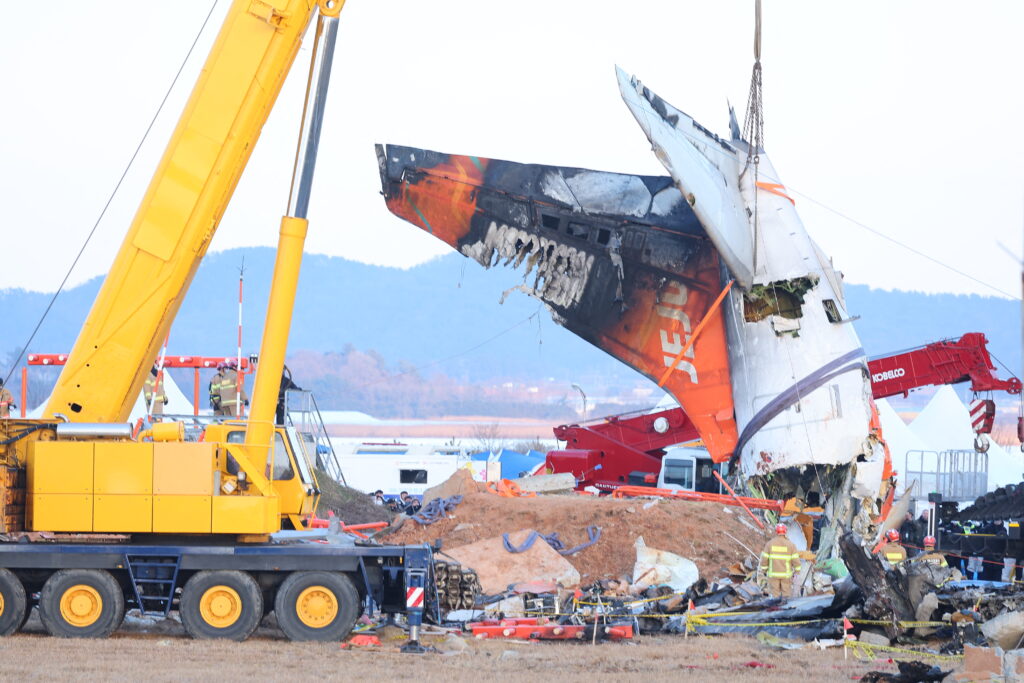
A crane lifts the tail section during the salvage operation of the Jeju Air Boeing 737-800 aircraft which crashed and burst into flames at Muan International Airport, in Muan on January 3, 2025.| Photo by YONHAP / AFP
MUAN, South Korea — South Korean investigators said Friday they expected to find more human remains as they began lifting the wreckage of the Jeju Air jet that crashed on landing last weekend killing all but two of the 181 passengers and crew aboard.
Flight 2216 from Bangkok to Muan broke up in a fiery ball of flames after colliding with a concrete installation at the end of the runway following a mayday call and emergency belly-landing.
The exact cause of the Boeing 737-800 crash is still unknown, but investigators have pointed to a bird strike, faulty landing gear, and the barrier at the end of the runway as possible issues.
READ MORE:
Small plane crashes into building in California, 2 dead, 18 hurt
Honeymoons, first foreign trips end in tragic plane crash
What caused South Korea’s most deadly plane crash
Using large yellow cranes, investigators began lifting sections of the plane’s scorched fuselage Friday, including what appeared to be an engine and the tail section.
“Today, we will lift the tail section of the plane,” said Na Won-ho, head of investigations for the South Jeolla provincial police.
“We expect there may be remains found in that section,” he told a press conference at Muan International Airport, where the crash happened.
Teams salvage an engine of the Jeju Air Boeing 737-800 aircraft which crashed and burst into flames at Muan International Airport, in Muan on January 3, 2025. | Photo by YONHAP / AFP
“For all that to be complete and to have the results, we must wait until tomorrow.”
Because of the violent destruction of the aircraft, officials said some of the bodies suffered extreme damage, and it was taking investigators time to piece them together while also preserving crash site evidence.
READ MORE: Funerals begin for 179 victims of deadly South Korea plane crash
All 179 victims have been identified, however, and some bodies have been released to families for funerals to begin.
Police have vowed to quickly determine the cause and responsibility for the disaster, but the transport ministry said it could take six months to three years.
BTS support
Police on Thursday conducted a series of raids on the offices of Jeju Air and the Muan airport operator as they stepped up their probe.
Police were securing evidence on the airport’s localizer — a concrete wall housing an antenna array at the end of the runway — as well as communications between the control tower and cockpit before the crash, Yonhap reported.
Officials are also inspecting all Boeing 737-800 aircraft operated by South Korean carriers, focusing on the landing gear.
Tributes are placed along a fence near the site where a Jeju Air Boeing 737-800 aircraft crashed and burst into flames at Muan International Airport in Muan, some 288 kilometres southwest of Seoul on January 2, 2025. | Photo by YONHAP / AFP
The investigation is headed by South Korean air safety officials, with the assistance of the US Federal Aviation Administration, which frequently aids with probes into global plane crashes.
China’s Civil Aviation Administration, meanwhile, announced Friday it was also taking measures in response to the Jeju Air crash.
It “comprehensively investigated runways for safety hazards” and “strengthened the… effectiveness of bird strike risk prevention”, state broadcaster CCTV reported, citing the administration’s safety director Shu Mingjiang.
In Muan, relatives of the victims visited the crash site to pay their respects and collect the belongings of their loved ones.
The disaster has spurred an outpouring of national support in South Korea, with a period of mourning lasting until Saturday and donations flooding in for victims’ families.
J-Hope, a member of K-pop megagroup BTS, sent 100 million won ($68,000) to the families as a “small measure of support”, according to the local Korea Herald newspaper.
In other acts of kindness, some Koreans had remotely pre-paid for coffee at the airport’s cafe so the victims’ families could drink without paying, while star chefs from Netflix hit “Culinary Class Wars” prepared meals.